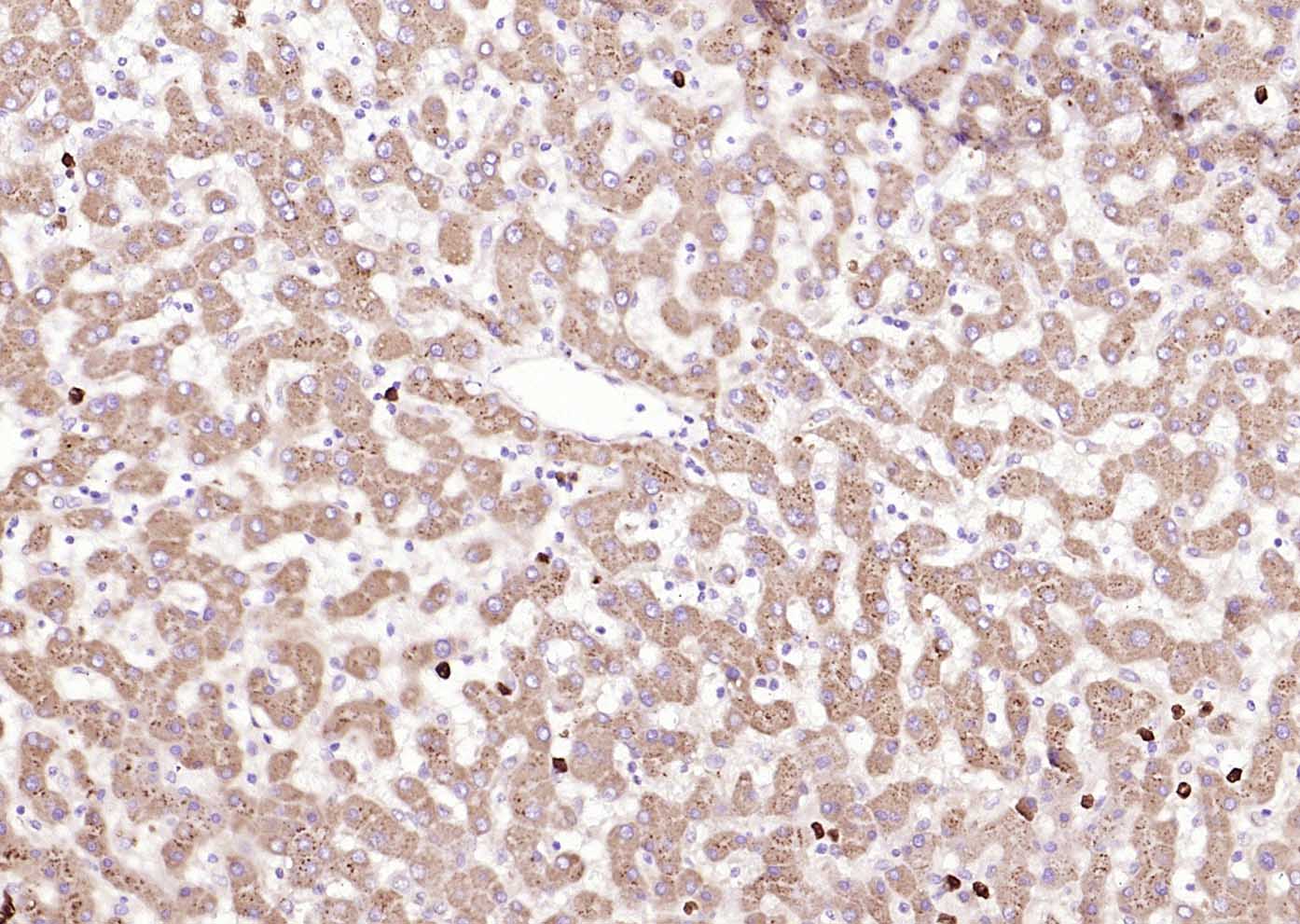MARCH6 Rabbit pAb
MARCH6 Rabbit pAb
- 产品详情
- 实验流程
- 背景知识
Application
| IHC-P, IHC-F, IF |
|---|---|
| Primary Accession | O60337 |
| Reactivity | Pig, Human, Mouse, Zebrafish, Dog, Horse |
| Host | Rabbit |
| Clonality | Polyclonal |
| Calculated MW | 102545 Da |
| Physical State | Liquid |
| Immunogen | KLH conjugated synthetic peptide derived from human MARCH6 |
| Epitope Specificity | 1-100/910 |
| Isotype | IgG |
| Purity | affinity purified by Protein A |
| Buffer | 0.01M TBS (pH7.4) with 1% BSA, 0.02% Proclin300 and 50% Glycerol. |
| SUBCELLULAR LOCATION | Endoplasmic reticulum membrane; Multi pass membrane protein. |
| SIMILARITY | Contains 1 RING-CH-type zinc finger. |
| SUBUNIT | Interacts with DIO2. |
| Post-translational modifications | Auto-ubiquitinated, which results in proteasomal degradation. |
| Important Note | This product as supplied is intended for research use only, not for use in human, therapeutic or diagnostic applications. |
| Background Descriptions | MARCH6 (Membrane associated RING finger protein 6) belongs to the MARCH family, which contains at least seven membrane associated RING-CH (MARCH)proteins. MARCH proteins are E3 ubiquitin ligases and are located to subcellular membranes. |
| Gene ID | 10299 |
|---|---|
| Other Names | E3 ubiquitin-protein ligase MARCHF6, 2.3.2.27, Doa10 homolog, Membrane-associated RING finger protein 6, Membrane-associated RING-CH protein VI, MARCH-VI, Protein TEB-4, RING finger protein 176, RING-type E3 ubiquitin transferase MARCHF6, MARCHF6 (HGNC:30550) |
| Target/Specificity | Present in brain (at protein level). |
| Dilution | IHC-P=1:100-500,IHC-F=1:100-500,IF=1:50-200 |
| Storage | Store at -20 °C for one year. Avoid repeated freeze/thaw cycles. When reconstituted in sterile pH 7.4 0.01M PBS or diluent of antibody the antibody is stable for at least two weeks at 2-4 °C. |
| Name | MARCHF6 (HGNC:30550) |
|---|---|
| Function | Endoplasmic reticulum membrane-associated E3 ubiquitin ligase that plays a critical role in mitigating endoplasmic reticulum stress, the regulation of cholesterol and lipid homeostasis, and ferroptosis (PubMed:25088257, PubMed:35941365, PubMed:39216628). Acts as a pivotal component of both the Ac/N-degron pathway (targeting the N-terminal acetyl group of substrates) and the ER-associated protein degradation- cytosol (ERAD-C) pathway (targeting misfolded substrates) (PubMed:30425097, PubMed:35941365). For instance, mediates the degradation of Ac/N-degron-bearing proteins such as the G-protein regulator RGS2 and the lipid droplet protein PLIN2 (PubMed:39216628). Suppresses endoplasmic reticulum stress and ferroptosis through cytosolic POMC degradation (By similarity). Prevents ferroptosis by acting as a NADPH sensor during lipid peroxidation through its C- terminal regulatory region (PubMed:35941365). Facilitates also the degradation of selected endoplasmic reticulum proteins by associating with signal peptide peptidase for the turnover of endogenous tail- anchored proteins (PubMed:29519897). Promotes ubiquitination of DIO2, leading to its degradation (PubMed:19651899). By ubiquitinating and thereby modulating the stability of many proteins of the cholesterol pathway including SQLE, CYP51A1, CYP11A1 and HMGCR, acts as a crucial post-translational regulator of cholesterol synthesis (PubMed:24449766, PubMed:31904814, PubMed:36958722). |
| Cellular Location | Endoplasmic reticulum membrane; Multi-pass membrane protein |
| Tissue Location | Present in brain (at protein level). |
Research Areas
For Research Use Only. Not For Use In Diagnostic Procedures.
Application Protocols
Provided below are standard protocols that you may find useful for product applications.
BACKGROUND
MARCH6 (Membrane associated RING finger protein 6) belongs to the MARCH family, which contains at least seven membrane associated RING-CH (MARCH)proteins. MARCH proteins are E3 ubiquitin ligases and are located to subcellular membranes.
终于等到您。ABCEPTA(百远生物)抗体产品。
点击下方“我要评价 ”按钮提交您的反馈信息,您的反馈和评价是我们最宝贵的财富之一,
我们将在1-3个工作日内处理您的反馈信息。
如有疑问,联系:0512-88856768 tech-china@abcepta.com.
¥ 1,500.00
Cat# AP59229























 癌症的基本特征包括细胞增殖、血管生成、迁移、凋亡逃避机制和细胞永生等。找到癌症发生过程中这些通路的关键标记物和对应的抗体用于检测至关重要。
癌症的基本特征包括细胞增殖、血管生成、迁移、凋亡逃避机制和细胞永生等。找到癌症发生过程中这些通路的关键标记物和对应的抗体用于检测至关重要。 为您推荐一个泛素化位点预测神器——泛素化分析工具,可以为您的蛋白的泛素化位点作出预测和评分。
为您推荐一个泛素化位点预测神器——泛素化分析工具,可以为您的蛋白的泛素化位点作出预测和评分。 细胞自噬受体图形绘图工具为你的蛋白的细胞受体结合位点作出预测和评分,识别结合到自噬通路中的蛋白是非常重要的,便于让我们理解自噬在正常生理、病理过程中的作用,如发育、细胞分化、神经退化性疾病、压力条件下、感染和癌症。
细胞自噬受体图形绘图工具为你的蛋白的细胞受体结合位点作出预测和评分,识别结合到自噬通路中的蛋白是非常重要的,便于让我们理解自噬在正常生理、病理过程中的作用,如发育、细胞分化、神经退化性疾病、压力条件下、感染和癌症。






